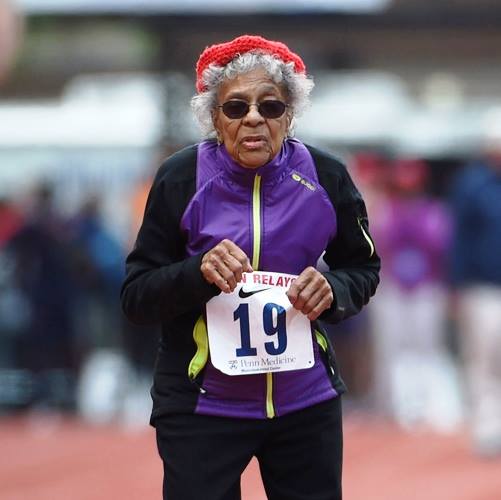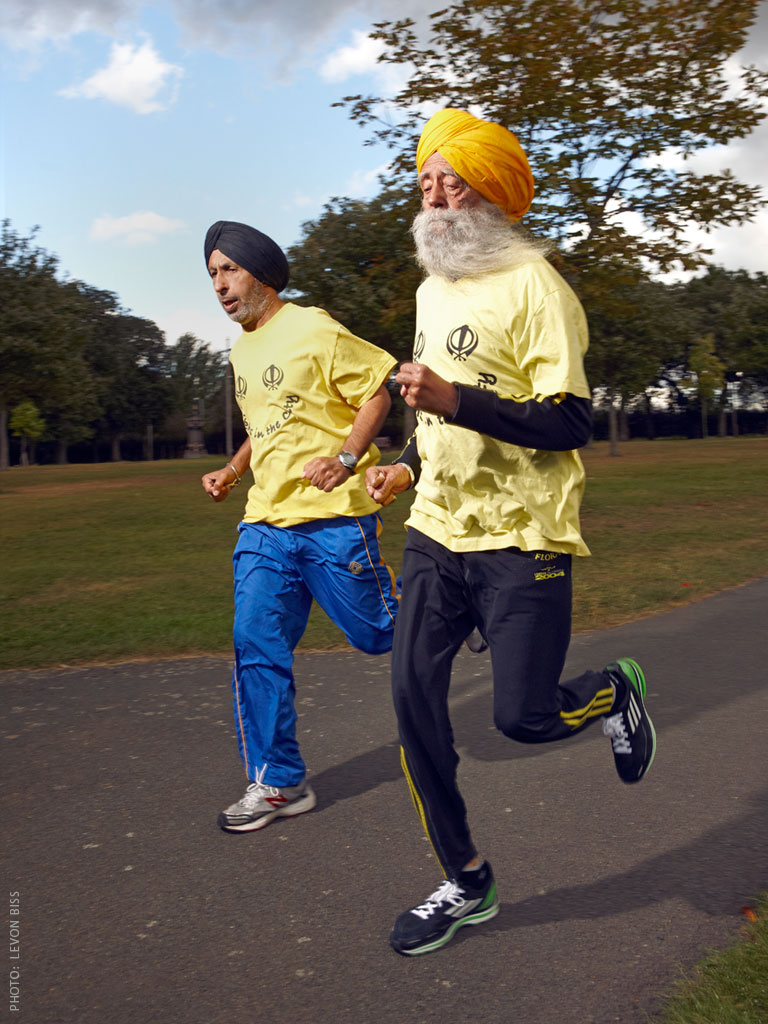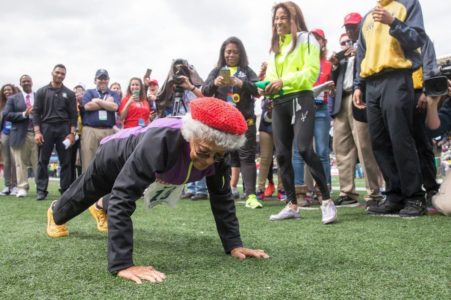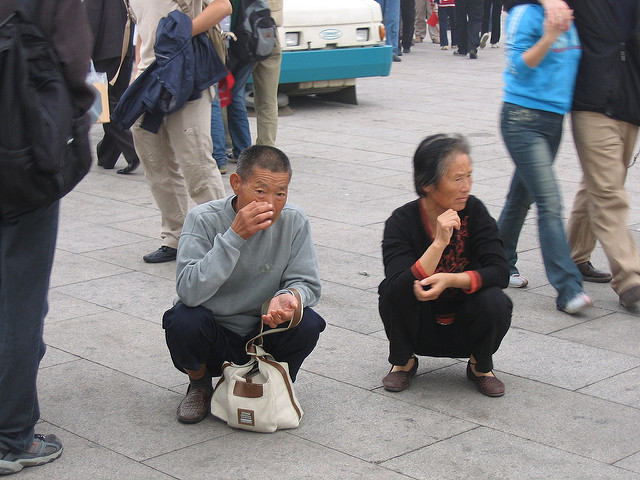Old broads: the golden years of pumping iron
 The other day I got an email from a woman who asked:
The other day I got an email from a woman who asked:
“I’m 31. Is it too late to begin a fitness program?”
Only in our youth-worshiping North American culture could such a question even be asked.
In most other cultures in the world, the concept of aging equaling inactivity does not exist.
- My next-door neighbour, a little old lady originally from Greece, is out every morning at 7 a.m. to do battle with the weeds in her vegetable garden.
- Ancient men and women can be seen scuttling everywhere in Chinatown with enormous loads of groceries perched on their backs.
- My landlord’s Portuguese father, a wizened man in his 70s, visited his son in Canada to “relax” by building a stone retaining wall.
- My grandfather, when he “retired”, built a house by himself.
You get the picture.
It’s never too late to start a fitness program.
It’s never too late to learn to move well.
It’s never too late to take care of yourself.
Even small changes can have significant effects.
Ida Keeling (below) took up running at 67. At 100, she set the record in the women’s over-80 100 metres.

Ida Keeling, 100 years old.
Fauja Singh started running in his late 80s, and just knocked off a marathon at age 105.

Of course, you have to be smart, sane, and safe.
Older bodies are not younger bodies, even if they look great and perform well.
In this article, I’ll explore how to put together a fitness program for a body “of a certain age”.
What defines “older” is a matter of opinion.
Our “biological age” may not match our chronological age.
In other words, what our body looks like on the inside, and how it performs, may not match the mileage.
If we haven’t taken good care of our bodies, they may show signs of aging early on.
If, on the other hand, we’ve been diligent about exercise, nutrition, stress management, etc. we may appear younger than the calendar suggests.
Of course, again:
We can change things any time.
We can’t go all the way back to our dewy-faced youth, of course. But we can certainly make some improvements, no matter how old we are.
As a wise older lady once said about lipstick, “Even an old house looks better with a fresh coat of paint.”
We used to think that aging always meant physical and mental degeneration.
Some effort was made to keep old people reasonably ambulatory, but in North America, we mostly just figured that aging just meant a long, miserable ride downhill.
Culturally speaking, in North America, older people were viewed as dependent and sickly.
In fact, most stats show that up to 85% of seniors are healthy, vigorous, and living independently.
(I think my 70 year old mom is somewhere on safari right now, or something. Honestly I can’t keep up with her adventures. She’s probably punching a gorilla at the moment. Meanwhile her 90 year old mom got kicked out of her seniors’ walking group for walking too fast.)
Only 2-5% of seniors are sufficiently disabled to require institutionalization.
In addition, it used to be thought that older people are unable to gain muscle or lose fat.
For this reason, nobody really bothered to find out what might happen if older people were put on a program of serious weight training.

Above, my beloved Grandma pumping iron in the pool.
Now, as our population ages, the face of the “senior” citizen is changing.
Far from going gently into that good night, older people of the late 21st century are kicking and screaming every step of the way.
Much more attention is now being given to debunking the myths that shaped our “knowledge” of aging.
Research is proving:
Most of what we thought to be part of “normal” aging was simply a result of physical inactivity and disuse.
Not to mention poor nutrition and lack of focus on preventive medicine.
If you think that at age 40 you’re over the hill, then you’re going to start to act like it. As my father in law likes to say, “If I’d known I was going to live this long, I would have taken better care of myself.”
Basically, your motto should be use it or lose it.
One of the biggest problems with aging is losing muscle.
Age-related muscle loss is commonly known as sarcopenia.
Lose muscle and a lot of stuff goes with it.
This includes things like:
- balance and stability;
- mobility and flexibility;
- daily-life strength and function;
- bone density; and
- metabolic health.
Regardless of whether you want to bust out a 400-lb deadlift on your 80th birthday, having enough muscle is important for health and function.
Few things make you feel like less of a schmuck who should’ve taken better care of yourself like getting stuck on the toilet, or struggling to open a jar.
(This, by the way, is why I do not respond to queries from misguided women asking me how to avoid gaining “too much” muscle. Muscle will go away on its own soon enough. Do not rush it.)
As we age, things change.
Our hormones change. Our tissues remodel more slowly. We recover more slowly from damage and inflammation.
Basically, the factory slows down.
This is a reality, no matter what you choose to do.
Yet we can — to some degree — affect the process of muscle loss and the other health concerns that go with it.
- We can stay active and keep that circulation moving, which affects overall metabolic health as well as brain function.
- We can lift weights, which helps build strength, muscle, and connective tissues.
- We can learn to move well in a variety of ways, which helps prevent falls and other injuries.
- We can eat our protein, which helps keep that muscle on.
On that last point, data suggest that older people may need more protein, rather than less.
When older people lift weights and (importantly) eat enough protein, they stay lean, strong and healthy even though they don’t necessarily break down and use protein as efficiently as younger people.
Strength training is a good thing… no matter how old you are.
The most important discovery for us to know about (which actually seems like common sense to me, but I guess I don’t get the big research bucks to come up with “breakthroughs”) is that resistance training gets results whether the trainee is 19 or 90.
Everyone benefits from a well-designed strength training program.
Training builds bone density.
Older people, especially women, are particularly prone to losing bone density. This means osteoporosis and more risk of serious fractures, such as hip fractures.
A hip fracture for a teenager means a short stay in the hospital. A hip fracture for a person in their 80s can mean death from a resulting infection or a long convalescence.
Weight training, combined with a diet rich in calcium and magnesium, is the best gift you can give to your bone density.
In fact, weight training has been shown to be more effective than simply supplementing minerals alone. After all, you need a stimulus to tell your body where to put those minerals.
And other good stuff.
Along with fighting age-related muscle loss, weight training:
- improves circulation
- helps regulate our body temperature (which older folks sometimes have trouble regulating)
- improves general work capacity
- eases arthritis and joint stiffness
- improves balance and stability
- builds up muscle around joints to prevent joint problems, and
- translates into functional strength for daily-life tasks such as carrying groceries or shoveling snow.
Weight training’s not a contact sport. It doesn’t involve trying to hit a projectile or smash your body around.
It doesn’t require any special skills or learning complex processes. It’s not, say, high jumping or platform diving.
It can be adapted to fit everyone’s individual needs.
Literally anyone can train with resistance.
Of course, you have to be smart about your program.
Here are some basic guidelines.
Build a foundation first.
Consider where you’re starting out, and look to build a broad base of physical capacity and skill first.
That means slowly building a repository of:
- movement skill (i.e. being able to do particular movements well and confidently);
- cardiovascular fitness and endurance (i.e. having a big heart-lung “engine”)
- muscular strength (i.e. being able to exert force powerfully)
- muscular endurance (i.e. being able to complete longer workouts while still moving well, rather than gassing out after a few repetitions)
- stability (i.e. being able to control your body in space, rather than wobbling around or feeling unsteady)
- mobility (i.e. being able to take all your joints through a normal range of motion, rather than being stiff or stuck)
Spend time on this. Practice. The basics are the basics for a reason.
Keep it real, but dream anyway.
Sure, smash those cultural expectations. Feel inspired and explore your potential.
At the same time, base your program in reality.
Perhaps one day you might crush the old-age-home powerlifting contest, but give yourself a few years of training at least.
If you’re using a trainer, find one with a clue.
Look for a coach who’s knowledgeable about aging and working with older people.
Don’t hire a trainer who doesn’t take your concerns seriously, who won’t challenge you enough because s/he thinks you’re “too old”, or who doesn’t appear to know how to tailor a program to your individual needs.
Consider a coach who is older, and has a better idea of how older bodies work. If your coach is a young whippersnapper, they better come correct with some serious credentials and expertise in aging, along with a healthy dose of empathy and understanding.
Your program should be safe and comfortable, yet also interesting and appropriately challenging.
Warm up. A lot.
More than you think you need.
That engine will take time to get running. Tissues need time to adapt to the new demands. Joints get stiffer with age, and need some extra work to get ready for loading.
For instance, I’m now in my mid-40s. I start my morning workout with slow walking at my treadmill desk for about 30-60 minutes. Or I’ll walk 15 minutes to the gym.
Once I officially start “the workout”, I’ll do at least another 10-15 minutes of warmups, mobility work, and light movement drills.
Here are some examples:
Eric Cressey Essential Mobility Drills
7 Mobility Drills to Improve Your Squat
Warmup and Joint Mobility Drills
You can do all kinds of things here.
The idea, though, is that the joints need time and light movement to get lubed up, and to progressively go through their ranges of motion.
Few exercises are truly off-limits.
Some folks assume that older people should stick to the foo-foo stuff and forgo free weights or challenging compound exercises such as squats.
While it’s true that the older trainee might need to work on building the skills, strength, and stability they need to do many exercises properly, that’s no different than any other beginner.

Remember Ida Keeling our 100 year old runner? She celebrated by busting out some pushups.
Muscles learn by doing.
If you need to learn balance, do exercises that help you develop it, not exercises that allow you to do without it.
Compound free weight exercises like squats, or pushups, or crawls force the body to function as an integrated system. You don’t learn stability by doing machine exercises that provide the stability for you.
That being said, older trainees will likely have to make allowances for beginning a program with reduced stability and balance, and gradually increase the level of difficulty in their exercise choice.
Move through as full a range of motion (ROM) as you can.
Develop strength in all positions.
If joints feel tight and restricted, work on mobility.
Don’t just assume limited motion is normal. It’s not.
Many places in the world still have squat toilets. Old folks there are knocking out full-depth squats that would make Olympic weightlifters proud.
It’s pretty normal in China, for instance, to see people of all ages just hanging out in a full squat.

Improve your real-world tasks first.
Carrying groceries… up stairs. Staying steady when your dog yanks your leash. Shoveling snow. (Or pushing your car out of the snow.) Playing with grandkids. Opening jars.
All of these and more translate into exercises that you can do in the gym to improve your real-life function.
Sure, sport performance is great, but it won’t get you off the toilet.
Look for functional exercises that challenge you to:
- move in three dimensions — up, down, side-to-side, front, back, in circles, etc.
- use as many pieces as possible — reaching, climbing, pushing, pulling, squatting, etc.
- move asymmetrically — one side doing something different than the other
- move awkward loads around — like a sandbag, or a keg, or a slosh pipe, or any other unevenly weighted object
Know yourself.
Know what good pain and bad pain feels like.
Know what your limits are, and when you can push them.
Watch your temperature and hydration levels.
Wear stuff that you’re comfortable in. Invest in good shoes. (30 Helens agree: You can’t pay too much for a good pair of shoes.)
Compression stuff is handy too. Personally, I swear by knee-high compression socks. They come in cute colours these days and make your calves feel extra-springy.
Don’t try to be a hero.
Really, haven’t you outgrown Jackass?
A lot of folks who chased the big poundages or epic athletic achievements are now living on a lot of painkillers.
Most of the time, trying to be a badass ain’t worth it. Tap out a little earlier, and live to fight another day.
Age is supposed to bring wisdom. Use it.
Dan John’s Easy Strength is based on the premise that stuff doesn’t have to be hard. Not every workout should be a gut-busting test of will.
Rather, what gets you results — and more importantly, keeps you in the game — is careful, consistent practice.
Give yourself plenty of recovery.
As we age, our sleep starts to suck. Repair slows down.
Recognize and respect your body’s need for recovery. Go after it and nurture it.
Get a massage. Soak in an Epsom salt bath. Do lots of light easy movement (such as walking) between workouts. Chase that recovery and build up a hefty bank account of resilience.
Don’t expect recovery to “just happen”. When you’re older, it won’t. Or at least, it’ll take you a lot longer.
Be smart about your supplements.
Talk to your pharmacist before you take any supplements. They may interact with any medications you’re on, or affect your health in ways you don’t expect.
Don’t just randomly take stuff.
Above all, don’t be intimidated by the younguns in the gym.
Get in there and have fun, and know that you’ll be the fittest old broad on the block.
Get inspired.
There are lots of places to look for inspiration these days.
91 year old Virginia Rizan trains at Wichita Falls Athletic Club. After a few months of training, she put her walker in the closet and hasn’t fallen in over a year.
An interview with Sister Madonna Buder, known as the “Iron Nun,” about doing triathlons at age 86.
At 57, Geri Hintenberger was the first woman to compete in the 20kg kettlebell long cycle event. She did a non-stop, full 10 minute set and knocked out 73 reps.
- The Barbell Prescription: Strength Training for Life After 40
- Wayne Westcott. Strength Training Past 50
- Ernestine Shepherd – Oldest known female bodybuilder at age 79 (in 2016)
- Clarence Bass’ site
- Former pro bodybuilder Dave Draper is in his 70s and still going strong
- Scott Glenn is a 75-Year-Old Knife-Fighting, Spear-Fishing Madman
This article below, about the late Morjorie Newlin, originally appeared in the Philadelphia Citypaper August 2006.
Flex Appeal
At 86, great-grandmother Morjorie Newlin keeps pumping iron.
Fourteen years ago, when Morjorie Newlin was 72, her neighborhood supermarket had 50-pound bags of kitty litter on sale. Without anyone to help her carry the bags back to her house, she struggled mightily under the load.
Never a particularly athletic woman, but staunchly independent, she decided that she had to do something about her deteriorating physical capabilities. Though osteoporosis was also on her mind, the septuagenarian began lifting weights — for her cat.
“I want to be as independent as I can be, for as long as I can,” says Newlin, a great-grandmother and retired nurse who turns 86 tomorrow. “I just want to do things for myself.”
After 13 years of weight training, Newlin is more than taking care of herself. At her two-story home in Mt. Airy, Newlin, who runs up the stairs with the sprightliness of a 10-year-old, has a room dedicated entirely to plaques, certificates and trophies (some almost as tall as her) from bodybuilding competitions that have taken her as far away as Italy, France and Germany. She’s won more than 40 trophies in her late-blooming career. “There are so many, I don’t know what to do with all of them,” she says.
“I chuckled when I saw this little old lady walk inside the gym,” says Richard Brown, a personal trainer at Rivers Gym in Mt. Airy, where Newlin began her training. “I was a little leery. I was just training young athletes at the time.”
The little old lady quickly showed him what an older athlete could do.
“She kept coming in day after day, week after week, and month after month,” Brown remembers. “She didn’t want to do ‘girly’ workouts. She wanted to train with us fellows. After a few months of training, I looked at her physique and knew she was ready for a [bodybuilding] show,” he continues. “She definitely had something to show.”

74 years old, on the bodybuilding stage. I want to give high fives for this until my hands fall off.
Newlin was bench-pressing 65 pounds when she was 73 years old. A year later she was throwing up 85.
Newlin recalls being a little reluctant when she saw the string bikini she’d have to wear in front of the bodybuilding audience.
“I knew the contest meant a lot to my trainer so I went along with it,” she says. To everyone’s surprise, Newlin won. The crowd went crazy on hearing she was 74 years old.
Newlin began her competition career in that AAU’s Master’s Division, which splits contestants into two categories: under and over a certain age limit, usually 35 or 45 years old. Newlin obviously fell way over the dividing line, wherever it was set, but was competing and winning against women half her age.
“I was always the oldest in all my competitions,” says Newlin.
The daughter of very active Barbadian immigrants, Newlin admits that athleticism is in her genes: “My family is used to walking and running long distances.”
Although she’s taking a break from bodybuilding competitions for now, Newlin is still training at least three days a week, now at Bally Total Fitness in Cedarbrook, and can still throw down with the best of them.
“I could bench-press 90 pounds with a spotter. I can dead lift 95 pounds. I can squat 135 pounds,” says Newlin.
She’s been featured on Oprah and The View, and has appeared in commercials in Barbados.
She spends her time out of the gym as a motivational speaker at schools and banquets, discussing the importance of exercise, weight training and dieting. “A lady called me earlier this week from Hawaii,” Newlin says. “She asked questions about how to use weights.”
Though some in her position might wonder how much longer they can keep it up — or how far they might have come if they’d started earlier — those questions never cross Newlin’s mind.
“Every day is different. The next day will take care of itself,” she says with Zen-like calm. “Age is only a number,” says Brown. “There is only one Morjorie Newlin. … She could do this for as long as she wants.”
